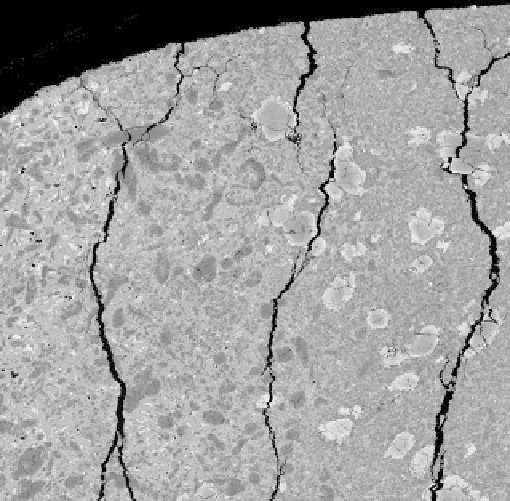Geology Reference
In-Depth Information
Additional lherzolitic shergottites occur in the U.S.
Antarctic collection: LEW 88516 [
Harvey et al.
, 1993;
Treiman et al.
, 1994] and the paired meteorites RBT
04261 and 04262 [
Usui et al.
, 2010]. All the lherzolitic
shergottites are similar in petrology and chronology, with
similar Mars launch ages (Figure 7.2), with the possible
exception of RBT 04261/2, suggesting that they were
derived from the same unit and sampled by the same
impact. The unique characteristics of RBT 04261/2
(Plate 73) are discussed by
Usui et al.
[2010].
matrix of pigeonite, augite, and maskelynite with minor
phosphates, ilmenite, pyrrhotite, and mesostasis. This
lithology comprises most of the meteorite, and being less
fractionated than basaltic shergottites, more closely
approximates a primitive martian magma. In contrast,
lithology B is a basaltic shergottite consisting of the same
phases as in the matrix of lithology A but is finer grained
and without the olivine and pyroxene megacrysts.
The megacrysts of olivine and pyroxene in lithology A
are not in equilibrium with the groundmass, and they
appear to be xenocrysts that reacted with and were partly
resorbed by the enclosing magma. They have been
suggested to be disaggregated xenoliths of harzburgite,
similar to ALH A77005 [
Steele and Smith
, 1982].
McSween
and Jarosewich
[1983] explored the possibility that assimi-
lation of megacrysts by a melt having the composition of
lithology B could have produced the groundmass compo-
sition of lithology A. However,
Wadhwa et al.
[1994]
calculated that the energy required to assimilate sufficient
harzburgite was more than could be provided by the
latent heat of crystallization.
Mittlefehldt et al.
[1999]
suggested that the energy required for assimilation could
be satisfied by impact melting. Another possibility is that
lithology A is a hybrid magma, formed by mixing of two
dissimilar magmas [
Wadhwa et al.
, 1994]. Neither model
satisfies all the geochemical constraints, although the
idea that the megacrysts are xenolithic is generally
accepted.
Goodrich
[2003] argued that the proportion of
actual xenocrysts is small, however, and that a highly
fractionated late-stage liquid was lost from the rock.
Herd
et al.
[2002] provided further data supporting the idea
that only the cores of megacrysts in EET A79001 are
xenocrystic. The crystallization histories of both lithol-
ogies were studied using crystal size distribution (CSD)
analysis by
Lentz and McSween
[2000]. The crystallization
age of EET A79001 is approximately 180 Ma [
Nyquist
et al.
, 2001].
Bulk analyses of major, minor, and trace elements in
lithology A and B were summarized by
Lodders
[1998].
The abundances of trace elements in minerals were
reported by
Wadhwa et al.
[1994].
The shergottites have provided important insights into
the oxidation state of the martian mantle source. Three
different oxybarometers have been developed. One
[
Wadhwa
, 2001] uses the partitioning of europium in
pyroxenes [
Wadhwa
, 2001], another [
Herd et al.
, 2001] is
based on the composition of spinel, and a third [
Herd
et al.
, 2002] utilizes the behavior of chromium and
vanadium in silicates [
Herd et al.
, 2002]. All three methods
give similar results of approximately QFM - 1.8 for the
two EET A79001 lithologies.
EET A79001 is highly shock metamorphosed. In the
curatorial description and following papers, the veins
and pockets of impact melt found throughout the rock
7.4. OLIvINE-PHYRIC SHERGOTTITE:
EET A79001
The case can be made that Elephant Moraine A79001
(Plate 70) is the most important of the SNC meteorites, at
least in an historical sense; this was the rock first identi-
fied as martian based on trapped gases, as described in
the introduction. But EET A79001 is an extremely impor-
tant meteorite for other reasons as well. A large (7.94 kg)
sample, it received considerable attention because it is the
first meteorite known to contain two different lithologies
(termed A and B) joined along an apparently igneous
contact (Figure 7.5) [
Steele and Smith
, 1982;
McSween
and Jarosewich
, 1983;
Mikouchi et al.
, 1999;
Goodrich
,
2003]. Lithology A is an olivine-phyric shergottite, the
first known sample of that lithology. It consists of mega-
crysts of olivine, orthopyroxene, and chromite, set in a
Figure 7.5.
Backscatter electron image of EET A79001, show-
ing textural and mineralogical difference between lithology A (on
right, with large, zoned olivine megacrysts) and lithology B (on
left). Image is ~4 cm across.

